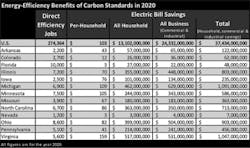Energy efficiency advocates have argued for years that energy efficiency should be a first fuel – considered before others in portfolio planning. Today, they appear victorious with the release of the US’ first-ever carbon dioxide restrictions for existing power plants.
The draft rule places energy efficiency in good position to be a top choice as states create strategies to meet the standard. Energy efficiency is not only inexpensive, but also politically palatable, say analysts.
“In addition to being the cheapest, cleanest and fastest way to cut down on carbon pollution, energy efficiency investments are strongly supported by the American people regardless of party,” said Peter Altman, director of NRDC’s Climate and Clean Air Campaign.
The proposal – likely to be finalized in about a year – gives states the flexibility to determine how they will meet the goal of reducing carbon emissions 30 percent by 2030.
As guidance, the EPA offers four building blocks that it found effective in analyzing action already underway in several states. One of the four is energy savings of 1.5 percent annually. The others include making fossil fuel plants more efficient, using more low emitting power like natural gas, maintaining nuclear power and continuing the renewable energy expansion now underway.
States already have been leading the way for years in reducing carbon emissions through energy efficiency and renewables, according to the EPA. The agency noted that 47 states have utilities that run demand-side energy efficiency programs, 38 have renewable portfolio standards or goals, and 10 have market-based greenhouse gas emissions programs.
“Together, the agency believes that these programs represent a proven, common-sense approach to cutting carbon pollution—one in which electricity is generated and used as efficiently as possible and which promotes a greater reliance on lower-carbon power sources,” the EPA said in releasing the plan.
Ernest Moniz, US energy secretary, said that the draft rule gives states “unprecedented flexibility to meet their obligations within an all-of-the-above set of options, tailored to each state’s needs and opportunities. A flexible approach will keep electricity affordable for American families and businesses, spark homegrown clean energy innovation that creates jobs, and increase energy efficiency to save families money.”
The plan can lead to $37.4 billion in savings on electric bills in 2020, if states use energy efficiency as the key approach to reduce carbon, according to NRDC. The group foresees a surge in energy efficiency-related jobs for electricians, roofers, carpenters, insulation workers, heating/air conditioning installers and heavy equipment operators, as a result of the carbon rule.
NRDC analysis of electricity bill savings if 13 states use energy-efficiency driven carbon reduction plans
The EPA also predicts that an efficiency-driven approach will lead to cost-savings. By 2030 the EPA expects electricity bills to be about eight percent lower than they would been without state action.
“The real story here is about economic opportunity,” said Steven Nadel, executive director of the American Council for an Energy-Efficient Economy. “Based on our recent study, we project that if states choose the efficiency path in the proposal, they would create hundreds of thousands of jobs and lower energy bills across the country by tens of billions of dollars a year.”
Bennett Fisher, CEO of Retroficiency, said that the decision by the EPA positions building efficiency to play a critical role.
“With 30 percent -50 percent of energy use routinely wasted, building efficiency represents a highly cost-effective, reliable and scalable way not only to reduce carbon emissions, but also boost our economy by saving businesses and consumers money,” Fisher said.
He added that “the EPA got it right when it put the onus on each state to determine its own carbon reduction strategy. There is no one-size-fits-all solution. To achieve these carbon reduction goals, tomorrow’s grid will need to optimize energy usage every minute of every day based on the best resource available at that time – be it clean generation sources, load shifting solutions, or permanent reductions through energy efficiency. Regional and local factors such as weather, building portfolio stock and energy prices all influence and inform the best approach.”
Stacey Davis, senior program manager of the Center for Clean Air Policy, noted that the rules also are likely to boost combined heat and power.
“The good news is that EPA has put forward a flexible approach that will encourage greater efficiency in how we use electricity. The guidance also allows states to take advantage of other domestic clean energy sources like natural gas and renewables—not just end-of-pipe control measures. One option that shouldn’t be overlooked is combined heat and power (CHP)—a technology that can lower energy costs for industrial, commercial and institutional energy consumers. For manufacturers, lower costs mean increased competitiveness,” Davis said.
CCAP recently released a study that highlights the role that CHP can play in lowering compliance costs.
The states must file the plans by June 30, 2016 (although a two year extension is possible under certain circumstances.) But even before that, the proposal undergoes a 120-day public comment period and further EPA review. A final rule is expected out in one year.
The EPA draft rule is here.
What’s your take on the EPA draft rule for carbon reduction. Join the discussion on Energy Efficiency Markets LinkedIn Group.







